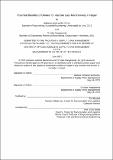Potential Benefits of Drones for Vaccine Last-Mile Delivery in Nepal
Author(s)
Lembcke Berninzon, Adriana; Vongasemjit, Ornipha
DownloadFull capstone (3.570Mb)
Metadata
Show full item recordAbstract
Nepal’s immunization coverage hovers around 78%, and 59 out of 77 districts have not yet been fully immunized. The objective of this study is to review the vaccine last-mile distribution to find a cost-efficient solution using a combination of modes of transportation to improve vaccine availability. This study determines which districts could use drones for last-mile delivery, quantifies the benefits from drone implementation, identifies locations for setting
drone bases and recommends appropriate drone types. First, a replicable district classification framework was used, from which six potential districts were selected for drone last-mile delivery. Then, an optimization model was created for two of these selected districts, analyzing parameters such as drone payloads and ranges, vaccine shipment sizes, and costs for each mode of transportation. This research demonstrates that implementing drones is suitable mainly in rural service points of the mountainous regions of Nepal. However, the implementation provides cost benefits only when start-up costs are subsidized or when the drone operation is outsourced by lower than $0.10 USD/dose. Addressing the problem of low immunization coverage could help reduce the mortality rate of children. Our solution could be expanded to vaccine distribution during the COVID-19 pandemic or even in disaster relief scenarios, when roads are inaccessible due to flooding or earthquakes.
Date issued
2021-06-09Keywords
network design, transportation, urban logistics